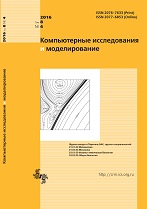|
This article is cited in 6 scientific papers (total in 6 papers)
MODELS IN PHYSICS AND TECHNOLOGY
Controlling the movement of the body using internal masses in a viscous liquid
A. A. Kilina, A. I. Klenovb, V. A. Tenenevb
a Udmurt State University,
1 Universitetskaya st., Izhevsk, 426034, Russia
b M. T. Kalashnikov Izhevsk State Technical University,
7 Studencheskaya st., Izhevsk, 426069, Russia
Abstract:
This article is devoted to the study of self-propulsion of bodies in a fluid by the action of internal mechanisms, without changing the external shape of the body. The paper presents an overview of theoretical papers that justify the possibility of this displacement in ideal and viscous liquids.
A special case of self-propulsion of a rigid body along the surface of a liquid is considered due to the motion of two internal masses along the circles. The paper presents a mathematical model of the motion of a solid body with moving internal masses in a three-dimensional formulation. This model takes into account the three-dimensional vibrations of the body during motion, which arise under the action of external forces-gravity force, Archimedes force and forces acting on the body, from the side of a viscous fluid.
The body is a homogeneous elliptical cylinder with a keel located along the larger diagonal. Inside the cylinder there are two material point masses moving along the circles. The centers of the circles lie on the smallest diagonal of the ellipse at an equal distance from the center of mass.
Equations of motion of the system (a body with two material points, placed in a fluid) are represented as Kirchhoff equations with the addition of external forces and moments acting on the body. The phenomenological model of viscous friction is quadratic in velocity used to describe the forces of resistance to motion in a fluid.The coefficients of resistance to movement were determined experimentally. The forces acting on the keel were determined by numerical modeling of the keel oscillations in a viscous liquid using the Navier–Stokes equations.
In this paper, an experimental verification of the proposed mathematical model was carried out. Several series of experiments on self-propulsion of a body in a liquid by means of rotation of internal masses with different speeds of rotation are presented. The dependence of the average propagation velocity, the amplitude of the transverse oscillations as a function of the rotational speed of internal masses is investigated. The obtained experimental data are compared with the results obtained within the framework of the proposed mathematical model.
Keywords:
motion in a fluid, self-promotion, the equations of movement, above-water screwless robot, Navier–Stokes equations.
Received: 06.04.2018
Accepted: 04.05.2018
Citation:
A. A. Kilin, A. I. Klenov, V. A. Tenenev, “Controlling the movement of the body using internal masses in a viscous liquid”, Computer Research and Modeling, 10:4 (2018), 445–460
Linking options:
https://www.mathnet.ru/eng/crm457 https://www.mathnet.ru/eng/crm/v10/i4/p445
|

| Statistics & downloads: |
| Abstract page: | 296 | | Full-text PDF : | 104 | | References: | 34 |
|




 Contact us:
Contact us: Terms of Use
Terms of Use
 Registration to the website
Registration to the website Logotypes
Logotypes








 Citation in format
Citation in format 
